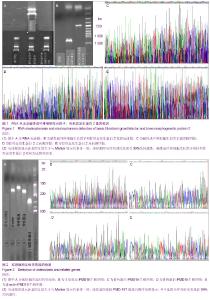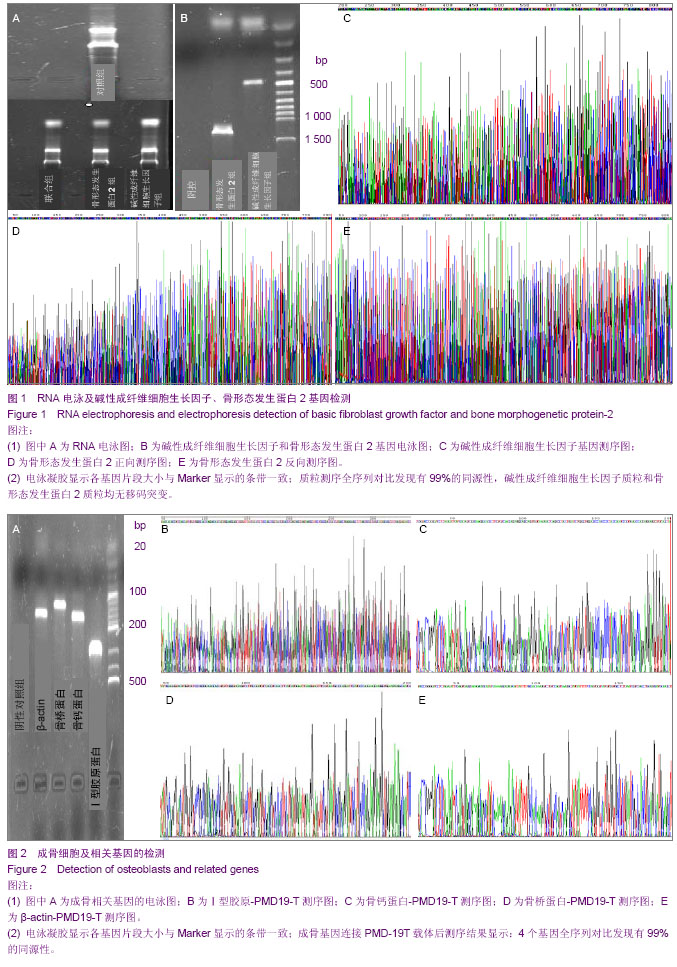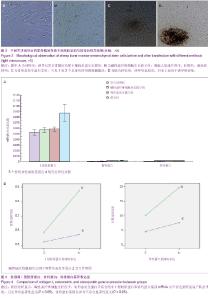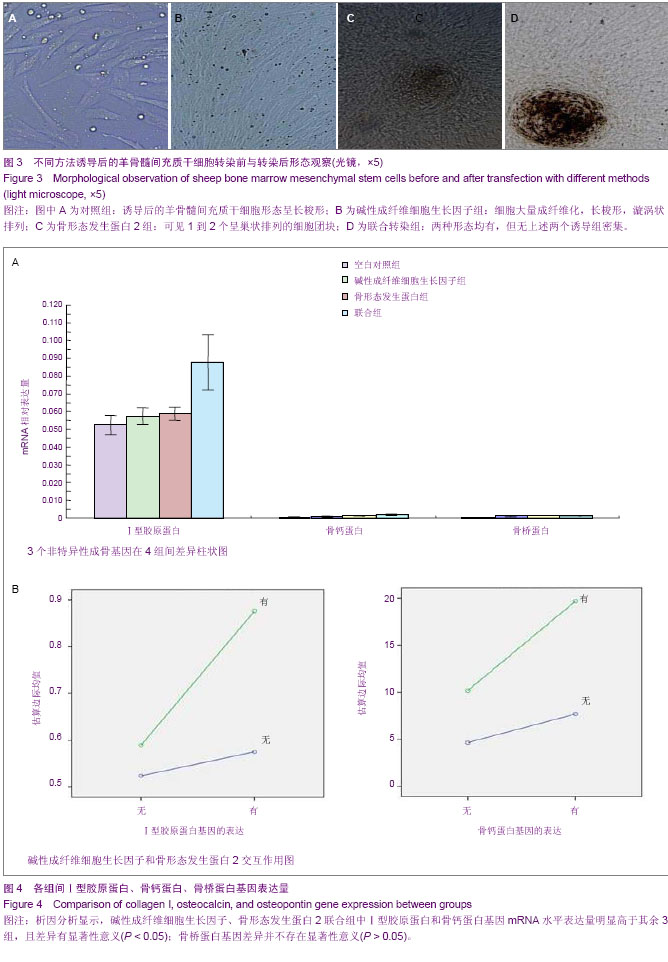| [1] Nicolay NH, Sommer E, Lopez R, et al. Mesenchymal stem cells retain their defining stem cell characteristics after exposure to ionizing radiation. Int J Radiat Oncol Biol Phys. 2013;87(5):1171-1178.[2] Naumann A, Dennis J, Staudenmaier R, et al. Mesenchymal stem cells--a new pathway for tissue engineering in reconstructive surgery. Laryngorhinootologie. 2002;81(7): 521-527.[3] Ripamonti U, Renton L. Bone morphogenetic proteins and the induction of periodontal tissue regeneration.Periodontol. 2006; 41(1):73-87.[4] 胡杨,盛磊,马莹,等.碱性成纤维细胞生长因子-慢病毒真核表达载体的构建及转染[J].中国组织工程研究与临床康复,2011, 15(6):1009-1014.[5] 李鹏,龙洁,汤炜,等.bFGF和骨形态发生蛋白2联合应用对体外培养兔骨髓间充质干细胞增殖与骨向分化的影响[J].现代生物医学进展,2008,8(6):1011-1015.[6] SchniderA, OvereschG, Korczak BM, et al.Com arison of real-time PCR assays for detection, quantification, and differentiation of camylobacter jejuniand camylobacter coli in broiler neck skin sam les. Food Prot. 2010;73(6): 1057-1063.[7] Cockrell AS, Kafri T.Gene delivery by lentivirus vectors. Mol Biotechnol. 2007;36(3):184-204.[8] 张经纬,冯建翔,徐荣明,等. 慢病毒介导碱性成纤维细胞生长因子基因转染促进半月板纤维软骨细胞的增殖与基质合成[J]. 中国组织工程研究与临床健康,2007,11(41):8267-8270.[9] Indraccolo S, Habeler W, Tisato V, et al. Gene transfer in ovarian cancer cells:Acomparison between retroviral and lentivial vector. Cance Res. 2002;62(21):6009-6107.[10] Bonab MM, Alimoghaddam K, Talebian F, et al. Aging of mesenchymal stem cell in vitro. BMC Cell Biol. 2006;7:14. [11] Kotev-Emeth S, Pitaru S, Pri-Chen S, et al. Establishment of a rat long-term culture expressing the osteogenic phenotype: dependence on dexamethasone and FGF-2. Connect Tissue Res. 2002;43(4):606-612.[12] Locklin RM, Oreffo RO, Triffitt JJ, et al. Effects of TGF and bFGF on thedifferenttiation of bone marrow stromal fibroblastss.Cell Biol Int.1999;23(3):185-194.[13] Koter ES, Pitaru S, Prichen S, et al. Establishment of a rat long-term culture expressing the osteogenic phenotype: dependence on dexamethasone and FGF-2.Connect Tissue Res.2002;43(4):606-612.[14] Xiao G,Jiang D,Gopalakrishnan R,et al. Fibroblast growth factor 2 induction of the osteocalcin gene requires MAPK activity and phosphorylation of the osteoblast transcription factor. Cbfal/Runx2. J Biol Chem.2002;277(39):36181-36187.[15] 李桥,汪敏,韦永珍,等.FGF-2 对体外培养人牙髓细胞FGFR和OPN 表达活性的影响[J].牙体牙髓牙周病学杂志,2011, 21(12): 675-678.[16] 曾融生,束煌,王剑宁.rhBMP2 诱导成肌细胞表达成骨表型的研究[J].中国口腔颌面外科杂志,2007,5(1):50-55.[17] 雷杰锋,雷光华.人膝骨关节炎软骨下骨OPN 的表达及其意义[J].现代生物医学进展,2011,22(11):4269-4272.[18] 薛松涛,施鑫.骨形态生成蛋白在成骨细胞分化机制中的研究进展[J].医学研究生学报, 2007,20(5):540-543.[19] Nakajima F, Ogasawara A, Goto K, et al. Spatial and temporal gene expression in chondrogenesis during fracture healing and the effects of basic fibroblast growth factor. J Orthop Res. 2001;19(5):935-944. [20] 王斌倡,罗毅文,胡年宏.骨康方含药血清对骨髓基质细胞成骨分化过程中Ⅰ型胶原基因表达的影响[J].中国骨质疏松杂志,2013, 19(9):946-949.[21] Viguet-Carrin S, Garnero P, Delmas PD. The role of collagen in bone strength. Osteoporos Int. 2006;17(3):319-336.[22] Huang W, Rudkin GH, Carlsen B, et al. Overexpression of BMP-2 modulates morphology, growth, and gene expression in osteoblastic cells. Exp Cell Res. 2002;274(2):226-234. [23] 杜俊杰,罗卓荆,胡蕴玉.rhBMP2在体内诱导成骨中Ⅰ、Ⅱ型胶原mRNA及碱性磷酸酶的表达[J].中国矫形外科杂志,2002,9(1): 43-45. [24] 李建军,许晓军,杨军,等.骨形态发生蛋白2和FGF-2对小鼠骨髓间充质干细胞向成骨细胞分化的影响[J].中国医科大学学报, 2006,35(1):69-71.[25] Nakashinma K,DE Crombrugghe B.Transcriptional mechanisms in osteoblast differentiation and bone formation.Trends in Genetics.2003;19(8):458-466.[26] Mayr-Wohlfart U, Kessler S, Knöchel W, et al. BMP-4 of Xenopus laevis stimulates differentiation of human primary osteoblast-like cells. J Bone Joint Surg Br. 2001;83(1): 144-147[27] 张为西,陈松林,姚晓黎. BMP-2和FGF-2对小鼠骨髓间充质干细胞向成骨细胞分化的影响[J].细胞与分子免疫学杂志,2008, 24(11): 1062-1065.[28] 李毅,陈槐卿.不同基因转染对骨髓基质干细胞成骨活性的影响[J].生物医学工程学杂志,2006,23(1):153-158.[29] 钱奇春,刘彦普,杨维东.骨形成蛋白-2和碱性成纤维细胞生长因子对人骨髓基质细胞的生物学作用[J].现代口腔医学杂志,2004, 18(4):380-381.[30] Yamasaki T, Deie M, Shinomiya R, et al. Transplantation of meniscus regenerated by tissue engineering with a scaffold derived from a rat meniscus and mesenchymal stromal cells derived from rat bone marrow. Artif Organs. 2008;32(7): 519-524. [31] Agung M, Ochi M, Yanada S, et al. Mobilization of bone marrow-derived mesenchymal stem cells into the injured tissues after intraarticular injection and their contribution to tissue regeneration. Knee Surg Sports Traumatol Arthrosc. 2006;14(12):1307-1314.[32] He Z, Li H, Zuo S, et al. Transduction of Wntl 1 promotes mesenchymal stem cells transdifferentiation into cardiac phenotypes. Stem Cells Dev. 2011;20(10):1771-1778.[33] Abdul-Ghani M, Dufort D, Stiles R, et al. Wntll promotes cardiomyocytes cardiomyocyte development by caspase- mediated suppression of canonical Wnt signals. Mol Cell Biol. 2011;31(1):163-178. |





